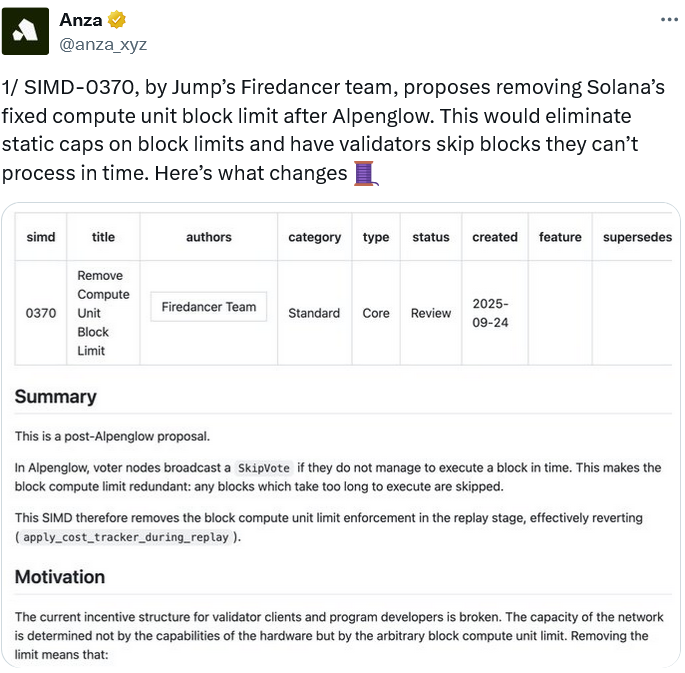Solana’s SIMD-0370 proposes removing the fixed compute block limit so block size scales with validator capacity, letting high-performance validators process complex blocks while slower nodes skip them, driving hardware upgrades and improved overall throughput for the network.
-
Removes static 60M compute unit cap to let block size scale by validator capacity
-
Incentivizes upgrades: validators that skip heavy blocks lose fees, encouraging investment in hardware and software optimization
-
Expected to boost throughput and finality when paired with Alpenglow and Firedancer deployment
Solana compute block limit update: SIMD-0370 proposes scaling blocks by validator capacity to boost throughput and incentivize upgrades — read the implications.
What is the Solana compute block limit proposal?
Solana compute block limit removal via SIMD-0370 would eliminate the fixed 60 million compute unit cap and let block size scale based on how many transactions each validator can process. This change aims to route complex blocks to high-performance validators while enabling lighter validators to skip heavy blocks and avoid overload.
How does SIMD-0370 change block sizing and validator incentives?
SIMD-0370 replaces a static block cap with dynamic sizing tied to validator capacity. Validators with higher throughput can include more transactions and earn more fees. Validators that cannot process complex blocks would skip them and forgo rewards, creating economic pressure to upgrade hardware or optimize clients.
Jump Crypto, which is developing the Firedancer validator client, proposed SIMD-0370 to follow the Alpenglow upgrade, according to Solana research firm Anza.
Anza describes the mechanism as a “performance flywheel”: block producers push limits to increase fees; validators that skip blocks lose rewards, prompting upgrades; upgraded validators allow producers to safely extend limits further.
SIMD-0370 arrives amid efforts to diversify validator clients and strengthen network resilience. Firedancer launched on mainnet in a limited capacity in September 2024 and is a central piece of these performance improvements.

When would SIMD-0370 be implemented relative to Alpenglow?
SIMD-0370 is targeted for implementation after the Alpenglow upgrade. Alpenglow recently passed in a near-unanimous vote and is scheduled for a testnet deployment in December 2025. Alpenglow is expected to be a foundational upgrade that reduces finality times and improves consensus performance.
What are the expected performance gains from Alpenglow and related upgrades?
Alpenglow aims to cut transaction finality from about 12.8 seconds to around 150 milliseconds. Combined with dynamic block sizing and Firedancer’s high-performance client, these upgrades target faster finality, higher throughput, and improved resilience against traffic spikes that previously caused network instability.
Why do some engineers warn about centralization risks?
Engineers caution that dynamic block sizing could favor well-capitalized validators. If large validators continually invest in expensive hardware, smaller validators may be unable to compete and could drop out, reducing validator diversity and increasing centralization risks.
Engineer Akhilesh Singhania noted on GitHub that sustained hardware-driven advantages could lead to fewer, larger validators dominating the network unless offset by incentives to keep validator participation broad.
What earlier proposals relate to the compute block limit?
Earlier this year, Jito Labs CEO Lucas Bruder proposed raising the fixed compute unit limit from 60 million to 100 million under SIMD-0286. SIMD-0370 differs by removing the static cap entirely and allowing per-validator scaling instead of a uniform global limit.
Frequently Asked Questions
How will removing the fixed compute block limit affect transaction fees?
Removing the fixed limit may increase short-term fee competition: block producers that can pack more transactions will collect more fees, potentially raising fee variance across validators but also rewarding higher throughput and efficiency.
Can smaller validators remain competitive after SIMD-0370?
Smaller validators can remain competitive by optimizing code, using efficient clients like Firedancer where feasible, or focusing on niche roles. However, some may need hardware upgrades to avoid frequently skipping blocks and losing fee revenue.
Key Takeaways
- Dynamic sizing: SIMD-0370 replaces the static 60M compute unit cap with per-validator scaling to match capacity.
- Incentives: High-performance validators process complex blocks and earn more fees; lower-capacity nodes may need upgrades.
- Risks and mitigation: Centralization concerns exist; careful validator economics and client diversity will be crucial.
Conclusion
SIMD-0370 proposes removing Solana’s fixed compute block limit to allow block sizing to scale with validator capacity, aiming to boost throughput and finality when combined with Alpenglow and Firedancer. Stakeholders should weigh performance gains against centralization risks and adopt incremental upgrades to maintain a resilient, decentralized network.
